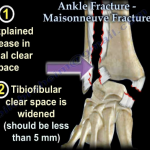Written by Alison Stickel
The Maisonneuve fracture is an injury that involves both a sprain and fracture to the ankle. This sport related injury disrupts the ankles’ integrity and ankle mortise, resulting in the need for surgery and physiotherapy.
Anatomy
Maisonneuve fracture involves the complete rupture of deltoid ligament, which is a term for the medial or inner ligaments of the foot that connect the inner portion of the tibia (medial malleolus) to the talus bone of the foot.
Other ligamentous injury occurs the rupturing of the anteriorinferior tibiofibular ligament and interosseous membrane or syndesmosis of the tibia and fibula. The rupture of these ligaments causes an unnatural separation between the tibia and fibula. This separation therefore disrupts the ankle mortise or bony arch of the foot.
The third component of the maisonneuve fracture is the fracture of the fibula. This fracture normally occurs proximally on the bone or closer to the foot. However, in some cases the fibula can break distally and still produce a maisonneuve fracture.
Causes
Generally this injury occurs in sports related falls. The maisonneuve fracture occurs when the foot hits the ground from a far distance and the fibula externally rotates unnaturally around the foot. This large impact and rotation causes the ankle to strain, unable to support the leg and causes the fibula to crack. Generally this injury is caused by sports incident that involves major leg elements or risk of falling such as gymnastics, cheerleading, diving, cycling, dance, and skiing.
Signs and Symptoms
- Pain in the medial side (inner portion) of the ankle
- Laxity/instability of the ankle
- Inability to move ankle
- Bruising and inflammation/swelling of the ankle
- Cracking noise
- Tenderness and pain of the fibula (extending on the outer side of the leg from the knee to the ankle)
- Bruising and swelling of the fibula
- Pain or inability with walking, standing or weight bearing
Medical Treatment
Because of the disruption of the ankle joint, it is vital to seek medical treatment immediately after injury. A trip to the emergency room and referral to an orthopedic surgeon is necessary. Generally surgery is required to insert screws or tight-loops into the ankle in order to reconstruct the unstable ankle and allow for torn ligaments to heal. Sometimes based on the severity, the fracture of the fibula will require the insertion of a metal plate to allow for correct healing.
Physiotherapy
Rest and rehabilitation will be vital in the healing process of this injury. Rest and non-weight bearing activity is advised for a period of 6 weeks. During this period the ankle up to the knee will be splinted or casted for immobilization. After around 6 weeks physical therapy should begin as the patient transitions into a walking boot. Physiotherapy exercises will involve stretching and strengthening of the ankle to maintain mobility and improve ankle range of motion. Stretching and strengthening exercises will allow the patient to return to gradual weight bearing activity at around 8-12 weeks and full weight bearing around 16 weeks. Return to sport after a maisonneuve fracture with rehabilitation occurs generally within a time frame of about 20-24 weeks.
Specific Physiotherapy treatments:
- Tailored exercise and stretching prescription to improve ankle range of motion at strength. Carried out with guidance of a physiotherapist.
- Cold laser therapy to stimulate healing of damaged ligaments
- Cold and ice modalities to improve swelling and stiffness
- Heat modalities such as ultrasound to improve tenderness of other ligaments and tendons of foot and ankle
- Guidance on management of weight bearing, activities including walking, running and usage of walking boot, and return to sport
Physiotherapy and rehabilitation is vital for correct healing, recovery, and prevention of re-injury!



